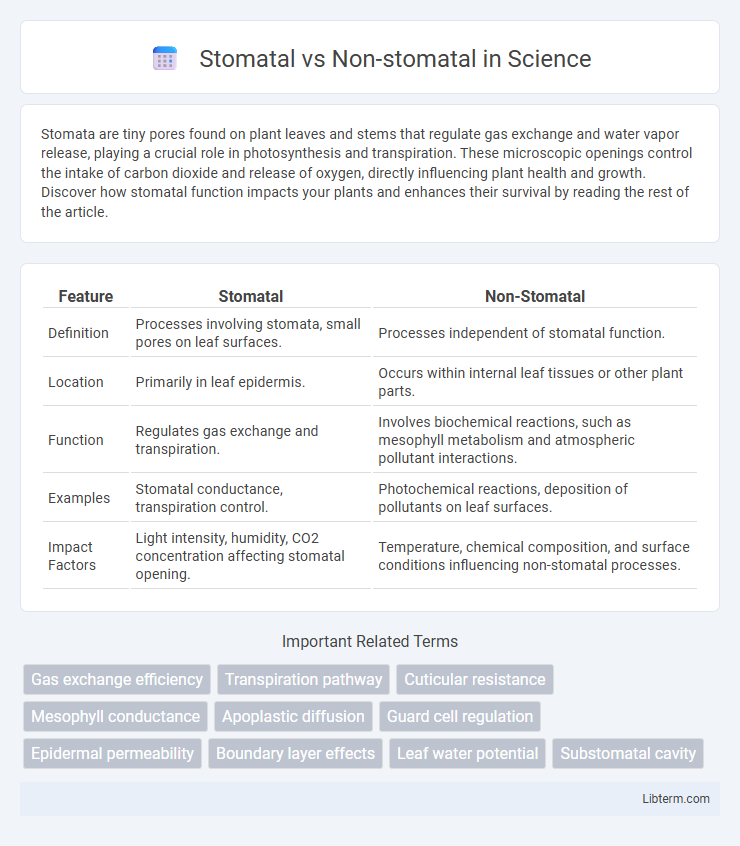Stomata are tiny pores found on plant leaves and stems that regulate gas exchange and water vapor release, playing a crucial role in photosynthesis and transpiration. These microscopic openings control the intake of carbon dioxide and release of oxygen, directly influencing plant health and growth. Discover how stomatal function impacts your plants and enhances their survival by reading the rest of the article.
Table of Comparison
| Feature | Stomatal | Non-Stomatal |
|---|---|---|
| Definition | Processes involving stomata, small pores on leaf surfaces. | Processes independent of stomatal function. |
| Location | Primarily in leaf epidermis. | Occurs within internal leaf tissues or other plant parts. |
| Function | Regulates gas exchange and transpiration. | Involves biochemical reactions, such as mesophyll metabolism and atmospheric pollutant interactions. |
| Examples | Stomatal conductance, transpiration control. | Photochemical reactions, deposition of pollutants on leaf surfaces. |
| Impact Factors | Light intensity, humidity, CO2 concentration affecting stomatal opening. | Temperature, chemical composition, and surface conditions influencing non-stomatal processes. |
Introduction to Stomatal and Non-stomatal Pathways
Stomatal and non-stomatal pathways regulate leaf gas exchange and photosynthesis under varying environmental conditions. Stomatal pathways control CO2 uptake and water vapor loss through microscopic pores called stomata, directly influencing transpiration and photosynthetic efficiency. Non-stomatal pathways involve mesophyll and biochemical processes that affect photosynthesis independently of stomatal conductance, including enzyme activity and chloroplast function.
Definition of Stomatal Processes
Stomatal processes refer to the regulation of gas exchange and water vapor release through microscopic pores called stomata, primarily found on plant leaves and stems. These pores control transpiration and photosynthesis by opening and closing in response to environmental cues such as light, humidity, and carbon dioxide levels. In contrast, non-stomatal processes involve biochemical and metabolic activities within the plant cells that influence gas exchange independently of stomatal aperture.
Definition of Non-stomatal Processes
Non-stomatal processes refer to factors affecting plant physiological functions, such as photosynthesis and transpiration, independent of stomatal behavior. These processes include biochemical limitations like enzyme activity reduction, photoinhibition, and mesophyll conductance alterations caused by environmental stresses such as drought, temperature extremes, and pollution. Unlike stomatal controls that regulate gas exchange through pore opening and closing, non-stomatal factors directly influence the internal metabolic and cellular mechanisms within the leaf.
Key Differences Between Stomatal and Non-stomatal Mechanisms
Stomatal mechanisms regulate gas exchange and water vapor release through microscopic pores called stomata, playing a crucial role in photosynthesis and transpiration. Non-stomatal mechanisms involve biochemical processes within the leaf mesophyll, such as enzyme activity and chlorophyll content, affecting photosynthetic efficiency independently of stomatal conductance. Key differences include their site of action, with stomatal mechanisms controlling diffusion pathways and non-stomatal mechanisms modulating internal leaf physiology and metabolic reactions.
Role of Stomata in Plant Physiology
Stomata are microscopic pores on plant leaves critical for regulating gas exchange, allowing carbon dioxide to enter for photosynthesis while controlling water vapor loss through transpiration. Their dynamic opening and closing balance internal CO2 concentration with water conservation, directly influencing photosynthetic efficiency and plant water use efficiency. Non-stomatal factors, such as biochemical processes within chloroplasts, also affect photosynthesis but without the direct control over gas exchange that stomata provide in plant physiology.
Non-stomatal Factors Influencing Plant Health
Non-stomatal factors influencing plant health include environmental stressors such as air pollution, UV radiation, and chemical exposure, which directly affect physiological processes beyond stomatal regulation. These factors can disrupt photosynthesis by damaging chlorophyll and cellular structures, leading to reduced growth and productivity. Soil quality and nutrient availability also play critical roles in mitigating non-stomatal stress impacts on plant vitality.
Environmental Impact on Stomatal and Non-stomatal Functions
Stomatal functions, primarily involving gas exchange through leaf pores, are highly sensitive to environmental factors such as light intensity, humidity, and CO2 concentration, which directly influence transpiration and photosynthesis rates. Non-stomatal functions, including biochemical processes like chlorophyll synthesis and enzyme activity, respond to environmental stressors like pollutants and temperature fluctuations, leading to impaired nutrient absorption and metabolic imbalance. Understanding the differential impacts on stomatal and non-stomatal activities is crucial for assessing plant resilience and ecosystem productivity under changing environmental conditions.
Examples of Stomatal vs Non-stomatal Responses
Stomatal responses involve changes in the opening and closing of stomata on leaf surfaces, regulating gas exchange and transpiration, as seen in plants under drought conditions where stomata close to reduce water loss. Non-stomatal responses refer to metabolic and physiological changes within the plant cells, such as inhibited photosynthesis due to chlorophyll degradation or enzyme activity reduction under stress. Examples include stomatal closure in soybean during water deficit versus decreased Rubisco enzyme activity in spinach under salinity stress, highlighting distinct adaptive mechanisms.
Importance in Agriculture and Crop Management
Stomatal and non-stomatal factors play crucial roles in regulating plant gas exchange and water loss, directly impacting crop productivity and stress resilience. Stomatal regulation controls photosynthesis efficiency and transpiration rates, influencing water use efficiency and drought tolerance in crops. Non-stomatal limitations, such as biochemical and mesophyll conductance factors, affect carbon assimilation independently of stomatal opening, making their understanding vital for optimizing crop management practices under variable environmental conditions.
Future Perspectives and Research Directions
Future perspectives in stomatal versus non-stomatal research emphasize integrating advanced imaging techniques and genetic engineering to improve plant drought resilience and photosynthetic efficiency. Emerging studies focus on elucidating molecular mechanisms underlying stomatal regulation and exploring non-stomatal pathways affecting gas exchange and water use efficiency under climate stress. Interdisciplinary approaches combining phenomics, genomics, and machine learning are key to developing crops with optimized stomatal behavior and enhanced tolerance to environmental changes.
Stomatal Infographic

 libterm.com
libterm.com